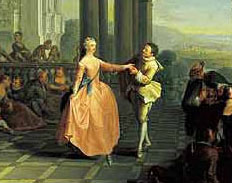
Dances of the Baroque Era

Dances of the Baroque Era
King Louis XIV of France was an enthusiastic dancer and had a great influence on the development
of a new form of dance. He was known as "The Sun King" because of a ballet role he performed at
the age of 14, where he represented the rising sun. During Louis' reign, two kinds of dance
developed: social dances for the ballroom and theatrical dances for court entertainments. The
two forms shared similar steps and styles, and both were practiced by the nobility. The highest
status for a dancer or musician was that of the amateurs (derived from amas, to love) —
those who loved their art for the purest reasons, as opposed to paid technicians. The amateurs
were indeed the finest dancers and musicians in the early Baroque courts. Balls would feature
elaborate entertainments created and performed by fellow members of the aristocracy.
Louis XIV formed the Academie Royale de Danse in 1661 for the creation, refinement and
standardization of the new style of dance. It is believed that the Academie required such
precision and detail in the new French dances in order to make other dancers dependent on court
academicians for further developments in the art.

The few weeks before Lent were especially busy with dancing. Court balls were held
every night, often lasting until dawn. No one was allowed to leave the dancing before the
King or Duchesse. A formal ball would open with a branle, where couples joined the linked
line in an exact social hierarchy that would establish the dancing order for the evening.
The most important dances of the ball were next: the many danses à deux, performed by one
couple at a time, beginning with those of the highest social rank. These dances included
the Menuet, Passepied, Sarabande, Gigue, Bourrée, Gavotte, Allemande, Forlane, Hornpipe,
Chaconne, Tarantelle, Rigaudon, Loure and Courante. Following the couple dances, the balls
would conclude with the increasingly popular English country dances (Contredanses),
brought back to France by Andre Lorin and other dance masters.

French fashions and taste dominated most of European society in the Baroque era. Courts of
other countries generally preferred the French dances, and often employed French dance masters.
The complex dances were recorded and disseminated through a new system of symbolic dance
notation devised by Pierre Beauchamp and/or Raoul Feuillet (there was a court battle over
the true authorship of the system, which Feuillet won). The first dance manual in Feuillet
notation was published around 1700, followed by many collections of notated dances issued for
each social season of the early 18th century.
King Louis XIV died, at 77, in 1715. The dances he helped create lived on through most of
the eighteenth century. Aristocrats continued to dance in court entertainments, but there was an
increasing trend toward the performance of noble dances by companies of professional
dancers. Theatrical dance developed into one of the most refined arts of the 18th century, a
tradition that continues today in ballet.
The French Revolution destroyed most of the Baroque high arts in 1789, including the court
dances. The removal of the French aristocratic strata uncovered a dance that had been
quietly developing in the countryside — a dance that would take the
ballrooms by storm in the next century: the waltz.
— Richard Powers